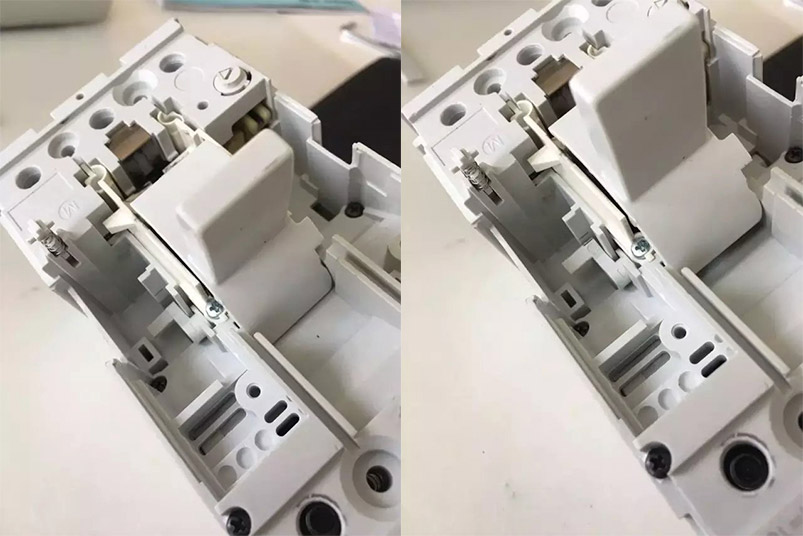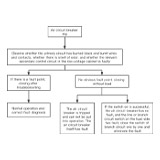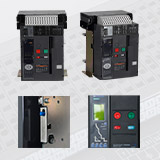Molded case circuit breakers(MCCBs) automatically cut off current when the current exceeds the trip setting. Plastic housing refers to the housing of a device using a plastic insulator to isolate between conductors and the grounded metal part. Molded case circuit breakers usually contain thermal magnetic trip units, while large moulded case circuit breakers are equipped with solid state trip sensors. Due to the very compact structure, the moulded case circuit breaker can hardly be serviced.

Nader Molded case circuit breakers(MCCBs)
Molded case circuit breakers are mostly operated manually and electrically operated with large capacity. Due to the application of electronic overcurrent trippers, molded case circuit breakers can also be classified into Class A and Class B. Class B has good three-stage protection characteristics. However, due to the price, the market share of Class A products using thermal-magnetic trippers is higher. Molded case circuit breaker installs contacts, arc extinguishing chambers, trippers and operating mechanism in a plastic case. Generally, maintenance is not considered. It is suitable for protective switches used as bypass. Overcurrent trippers are of thermal magnetic type and electronic type.
Working Principle of Molded Case Circuit Breaker
The main contact of low voltage circuit breaker is operated manually or electrically. After the main contact is closed, the free release mechanism locks the main contact in the closing position. The coil of the over-current release and the thermal element of the thermal release are in series with the main circuit, and the coil of the under voltage release is in parallel with the power supply.

When the circuit is short circuited or seriously overloaded, the armature of the over-current release is closed to make the free tripping mechanism act, and the main contact disconnects the main circuit.
When the circuit is overloaded, the thermal element of the thermal release will be heated, which will bend the bimetallic sheet, push the free release mechanism to act, and the main contact will disconnect the main circuit.
When the circuit is under voltage, the armature of the under voltage release releases, which also makes the free release mechanism act, and the main contact disconnects the main circuit.
When the shunt release button is pressed, the armature of shunt release will be closed to make the free tripping mechanism act and the main contact will disconnect the main circuit.

1. Base, 2. Cover, 3. Arc extinguishing chamber, 4. Handle (wrench), 5. Gusset plate, 6. Bimetallic sheet (thermal protection element), 7. Adjusting screw for time delay protection (overload thermal protection), 8. Instantaneous protection adjusting knob, 9. Lower bus (connected to load end), 10. Heating element, 11. Spindle, 12. Soft connecting wire, 13. Moving contact, 14. Static contact, 15. Upper bus (connected to power supply end)

Molded case circuit breaker
Characteristics of moulded case circuit breaker
1. Rated limit short circuit breaking capacity ICU
There are two kinds of breaking capacity indexes of circuit breaker: rated limit short-circuit breaking capacity ICU and rated operating short-circuit breaking capacity ICs. ICs, as a characteristic parameter, not only considers the breaking capacity of the circuit breaker, but also serves as a breaking index, within the specified number of breaking short circuit faults, the normal operation of the circuit breaker can be ensured.
2. Current limiting and breaking capacity
When the circuit breaker is short circuited and the contact is opened rapidly, an arc is generated, which is equivalent to a rapidly increasing arc resistance in series in the line, thus limiting the increase of fault current. The less the breaking time of circuit breaker is, the closer ICs will be to ICU, and the better current limiting effect will be. The adverse effects of electromagnetic effect, electric effect and thermal effect caused by short circuit current on circuit breaker and electrical equipment can be greatly reduced, and the service life of circuit breaker can be prolonged.
3. Short circuit protection
Short circuit protection is short circuit instantaneous trip. Attention should be paid to timely adjust the setting value of the protection after the load changes, so as to prevent the power supply quality from being affected by frequent tripping when the setting value is too small. Or the line and equipment cannot be effectively protected if the setting value is too high.
4. Overload delay protection
Overload delay protection means that the load current exceeds the limited range of the equipment, and there is a risk of burning the equipment. The protection device can cut off the power supply within a certain period of time. Overload has a process of heat accumulation, and the protection action does not need to be too fast. For short-time over-current, the protection should not act.
5. Isolation function
The isolation function is to require that the leakage current after the circuit breaker is disconnected will not cause harm to people and equipment. After several short circuit trips, the switch performance decreases and the leakage current increases. For human body, the leakage current below 30mA is the safe leakage current, while in the harsh environment, the leakage current over 300mA lasts for more than 2 hours, which may cause insulation damage and lead to phase to ground short circuit and fire.

Function of moulded case circuit breaker
1. Connect and disconnect the no-load and load current in the high-voltage circuit under normal conditions.
2. In case of system failure, it can cooperate with the protection device and automatic device to cut off the fault current quickly to prevent the accident from expanding, so as to ensure the safe operation of the system.
Main parameters of moulded case circuit breaker
1. Breaker shell frame grade
The rated current of circuit breaker shell level refers to the rated current of the maximum release that can be installed in the frame and plastic shell with the same basic size. The rated current of the circuit breaker refers to the current that the release in the circuit breaker can pass for a long time, also known as the rated current of the circuit breaker release. In the same series, there are multiple rated currents in the same shell rating, and there are multiple rated currents in the same shell rating current.
The current setting value of the release refers to the multiple of rated current in, which is the action current value. For example, if the over-current is set to 1.2, 1.3, 5 and 10 times of the current, it is written as IR = 1.2In, 1.3In, 5In, 10In, etc. Now some electronic release, its overload long delay rated current is adjustable, the adjusted current, in fact, is still the rated current, is the maximum current that can be passed for a long time.
The rated working current is the actual working current of the contact under a certain working voltage when the circuit breaker is equipped with auxiliary contacts (accessories). The current is 3A or 6A, which is used to control and protect the circuit.
2. Rated insulation voltage
The rated insulation voltage is the voltage value of the designed circuit breaker, and the electrical clearance and creepage distance shall be determined according to this value. Some circuit breakers do not specify the rated insulation voltage, the maximum value of the rated working voltage should be regarded as the rated insulation voltage. In any case, the maximum rated working voltage should not exceed the rated insulation voltage.
The rated control power supply voltage is the voltage when the moulded case circuit breaker is equipped with shunt release and electric mechanism accessories. There are two kinds of voltage: AC and DC, which must be indicated when selecting.
3. Rated limit short circuit breaking capacity
The rated limit short circuit breaking capacity is breaking capacity under specified conditions. After acting according to the specified test procedure, it is not considered that the circuit breaker continues to carry its rated current.
Rated short circuit breaking capacity refers to the breaking capacity under specified conditions. After the specified test procedure, it is necessary to consider that the circuit breaker continues to carry its rated current.
In order to meet the needs of different users, many circuit breaker manufacturers now divide the short-circuit breaking capacity of the same shell rating current into different levels, and users can choose the appropriate circuit breaker according to their needs.
The value of the rated short circuit breaking capacity can be 25%, 50%, 75%, 100% of the rated ultimate short-circuit breaking capacity. Most circuit breakers are 50% to 75%, and very few have 100% (Ics=Icu).
4. Accessory function
As the derivation and supplement of circuit breaker functions, accessories add control means and expand protection functions for circuit breakers. They are an integral part of circuit breakers, mainly including auxiliary contacts, alarm contacts, shunt release, under voltage release, electric operating mechanism, external rotary operating handle and other accessories.
(1) The auxiliary contact is mainly used to display the opening and closing status of the circuit breaker, but it can not show whether it is fault tripping. It is connected in the control circuit of the circuit breaker. The rated current of the molded case circuit breaker shell frame grade is 100 as the single break point transfer contact, and the bridge type contact structure is 225 and above, with the agreed heating current of 3A; Two normally open and two normally closed can be installed for shell frame with rated current of 400 and above, and the agreed heating current is 6A.
(2) Alarm contact is mainly used for the free tripping of the circuit breaker when the load is overloaded, short circuit or under voltage. The working current of alarm contact is AC380V, 0.3A, dc220v, 0.15A, which will not exceed 1A generally, and the heating current can be 1-2.5a.
(3) Shunt release is a kind of remote control opening accessories, its voltage can be independent of the main circuit voltage, shunt release is short-term working system, the coil power on time generally can not exceed 1s, otherwise the coil will be burned. In order to prevent the coil from burning out, a microswitch is connected in series in the shunt release coil of the moulded case circuit breaker. When the shunt release is powered on and the armature is closed, the microswitch changes from the normally closed state to the normally open state. Because the control circuit of the power supply of the shunt release is cut off, even if the button is pressed artificially, the shunt coil will not be powered on. When the circuit breaker is closed again, the microswitch will be in the normally closed position again. The shunt release has a variety of control voltage and different power frequency, which can be used in different occasions and different power sources.
(4) Under voltage release is used as long-term voltage protection of lines and power equipment. When in use, the coil of under voltage release is connected to the power supply side of the circuit breaker. The circuit breaker can only be closed after the undervoltage release is powered on, otherwise the circuit breaker cannot be closed. The user should confirm whether the working voltage of the circuit is consistent with that of the under voltage release. The operating range of under voltage is 70% ~ 35% UN. Under voltage release also has a variety of rated operating voltage and different power frequency, which can be used in different occasions and different power supply.
(5) The electric operating mechanism is used for automatic control of circuit breaker and remote closing and opening. There are two kinds of electric operating mechanism and electromagnetic operating mechanism: the electric operating mechanism is driven by motor, which is generally applicable to the circuit breaker with shell rating of 400A and above; the electromagnet operating mechanism is applicable to the circuit breaker with shell rating of 225A and below.

Accessory function
5. Arcing distance
When a circuit breaker breaks a large short-circuit current, its moving and static contacts are separated to produce an arc. A part of the arc or ionized gas is ejected from the arc nozzle at the power supply end of the circuit breaker. The arc itself is a huge current, which is easy to cause phase to phase short-circuit and ground short-circuit accidents between bare conductors, between bare charged bodies and "ground"(the metal shell of the complete equipment is grounded). To ensure safety, users should keep a certain distance according to the data provided by the manufacturer's product samples or operation instructions. If the height distance of distribution box and cabinet is not enough, products with small arc distance or zero arc can be selected to ensure the safety of power consumption.
Working conditions of moulded case circuit breaker
1. Ambient air temperature
The upper limit of ambient air temperature is +40℃; the lower limit of ambient air temperature is -5℃; the average value of ambient air temperature in 24h does not exceed +35℃.
2. Altitude
The altitude of the installation site usually does not exceed 2000m.
3. Atmospheric conditions
The relative humidity of the atmosphere does not exceed 50% when the ambient air temperature is +40℃; it can have a higher relative humidity at a lower temperature; the monthly average maximum relative humidity of the wettest month is 90%, and the monthly average of the month is the lowest The temperature is +25℃, and the condensation on the surface of the product due to temperature changes needs to be considered.
If it is necessary to use moulded case circuit breaker in extreme environment, it is necessary to confirm that the selected product can operate normally in extreme environment.

Molded case circuit breaker
Selection of moulded case circuit breaker
(1) Firstly, the category is selected according to the specific conditions, and then the specific parameters are determined according to the rated current of the circuit and the requirements for protection. When the rated current is below 630A and the short circuit current is small, the moulded case circuit breaker is preferred. The rated current is relatively large, frame circuit breaker (ACB) or moulded case circuit breaker with good performance can be used instead. For the branch with large short-circuit current, attention should be paid to whether the current limiting capacity of the circuit breaker can meet the requirements. When leakage protection is required, the circuit breaker must have this function.
(2) After the type and parameters of circuit breaker are determined, the cost performance ratio is the key factor to choose among many products. Under the condition of meeting the basic requirements, the circuit breaker should be safe and reliable, and it is better to have certain expansibility, such as adjusting to adapt to the changes of future load in a certain range, adding module units to realize function expansion, etc.


















